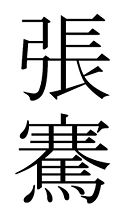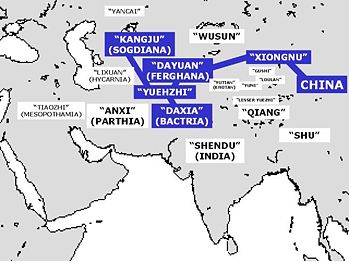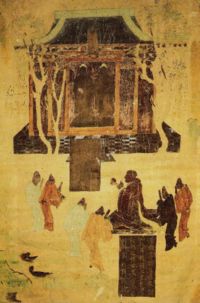Zhang Qian
2008/9 Schools Wikipedia Selection. Related subjects: General history; Historical figures
| Zhang Qian 張騫 |
|
 Zhang Qian taking leave from emperor Han Wudi, for his expedition to Central Asia from 138 to 126 BC, Mogao Caves mural, 618 - 712.
|
|
| Born | 195 BC Hanzhong, Shaanxi, China |
|---|---|
| Died | 114 BC China |
| Occupation | Explorer and diplomat |
Zhang Qian ( 張 騫; Wade-Giles Chang-k'ien) was an imperial envoy to the outside world in the 2nd century BC, during the time of the Han Dynasty. He was the first official diplomat to bring back reliable information about Central Asia to the Chinese imperial court, then under Emperor Wu of Han, and played an important pioneering role in the Chinese colonisation and conquest of the region now known as Xinjiang.
Today Zhang Quian's travels are associated with the major route of transcontinental trade, the Silk Road. In essence, his missions opened up to China the many kingdoms and products of an unknown and new part of the world. Zhang Qian's accounts of his explorations of Central Asia are detailed in the Early Han historical chronicles (" Records of the Grand Historian" or "Shiji"), compiled by Sima Qian in the 1st century BC . Today Zhang Quian is considered a national hero for the key role he played in opening China to the world of commercial trade.
Zhang Qian's Missions

Zhang Qian was born just east of Hanzhong in the north central province of Shaanxi, China. He entered the capital, Chang'an, today's Xi'an, between 140 BC and 134 BC as a Gentleman (郎), serving Emperor Wu of Han of the Han Dynasty. At the time the nomadic Xiongnu tribes, the name given the Turkic peoples of Central Asia by the Chinese, controlled what is now Inner Mongolia and dominated the Western Regions, Xiyu (西域 ), the areas surrounding the territory of the Han Dynasty. The Han emperor was interested in establishing commercial ties with distant lands but outside contact was prevented by the hostile Xiognu.
The Han court dispatched Zhang Qian, a military officer who was familiar with the Xiongnu, to the Western Regions in 138 BC with a group of ninety-nine members to make contact and build an alliance with the Yuezhi against the Xiongnu. He was accompanied by a Xiongnu guide named Ganfu (甘父), a Xiongnu who had been captured in war, who was a skilled archer. The objective of Zhang Qian's first mission was to seek a military alliance with the Yuezhi, in modern Tajikistan. However to get to the territory of the Yuezhi he was forced to pass through land controlled by the Xiongnu who captured him (as well as Ganfu) and enslaved him for ten years. During this time he married a Xiongnu wife and gained the trust of the Xiongnu leader.
Zhang and Ganfu (as well as Zhang's wife) were eventually able to escape and, passing Lop Nor and following the northern edge of the Tarim Basin, around the Kunlun Mountains and through small fortified areas in the middle of oases in what is now Xinjiang until they made their way to Dayuan and eventually to the land of the Yuezhi. The Yuezhi were agricultural people who produced strong horses and many unknown crops including alfalfa for animal fodder. However, the Yuezhi were too settled to desire war against the Xiongnu. Zhang spent a year in Yuezhi and the adjacent Bactrian territory, documenting their cultures, lifestyles and economy, before beginning his return trip to China, this time following the southern edge of the Tarim Basin.
On his return trip he was again captured by the Xiongnu who again spared his life because they valued his sense of duty and composure in the face of death. Two years later the Xiongnu leader died and in the midst of chaos and infighting Zhang Qian escaped.
Zhang Qian returned in 125 BC with detailed news for the Emperor, which showed that sophisticated civilizations existed to the West, with which China could advantageously develop relations. The Shiji relates that "the emperor learned of the Dayuan, Daxia, Anxi, and the others, all great states rich in unusual products whose people cultivated the land and made their living in much the same way as the Chinese. All these states, he was told, were militarily weak and prized Han goods and wealth". . Upon Zhang Qian's return to China he was honoured with a position of palace counselor. Although he was unable develop commercial ties between China and these far-off lands, his efforts did eventually result in trade mission to the Wu-sun people in 119 BC which led to trade between China and Persia.
On his mission Zhang Quian had noticed products from an area now known as northern India However, the task remained to find a trade route not obstructed by the Xiongnue to India. Zhang Quain set out on a second mission to forge a route from China to India via Sichuan, but after many attempts this effort proved unsuccessful. In 115 BC Zyhang Qian was sent on a third mission by the emperor, to develop ties with the Wusun people living southeast of Lake Balkhash in what is now the Ili Kazakh Autonomous Prefecture.
Zhang Qian's reports
The reports of Zhang Qian's travels is quoted extensively in the 1st century BC Chinese historic chronicles "Records of the Great Historian" ( Shiji) by Sima Qian. Zhang Qian visited directly the kingdom of Dayuan in Ferghana, the territories of the Yuezhi in Transoxonia, the Bactrian country of Daxia with it remnants of Greco-Bactrian rule, and Kangju (康居). He also made reports on neighbouring countries that he did not visit, such as Anxi ( Parthia), Tiaozhi (Mesopotamia), Shendu (India) and the Wusun.
Dayuan (Ferghana)
Zhang Qian starts with a report on the first country he visited (after his captivity among the Xiongnu), Dayuan, in Ferghana, west of the Tarim Basin. They are considered by him as sophisticated urban dwellers, on the same footing as the Parthian and the Bactrians. The name Dayuan (meaning Great Yuan), may be a transliteration of the word Yona used to designate Greeks, who occupied the region from the 4th to the 2nd century BC.
- "Dayuan lies southwest of the territory of the Xiongnu, some 10,000 li (5,000 kilometers) directly west of China. The people are settled on the land, plowing the fields and growing rice and wheat. They also make wine out of grapes. The people live in houses in fortified cities, there being some seventy or more cities of various sizes in the region. The population numbers several hundred thousand" ( Shiji, 123, Zhang Qian quote, trans. Burton Watson).
Yuezhi (Tocharians?)
After obtaining the help of the king of Dayuan, Zhang Qian went southwest to the territory of the Yuezhi, with whom he was supposed to obtain a military alliance against the Xiongnu.
- "The Great Yuezhi live some 2,000 or 3,000 li (1,000 or 1,500 kilometers) west of Dayuan, north of the Gui ( Oxus) river. They are bordered to the south by Daxia (Bactria), on the west by Anxi (Parthia), and on the north by Kangju (康居). They are a nation of nomads, moving place to place with their herds and their customs are like those of the Xiongnu. They have some 100,000 or 200,000 archer warriors." ( Shiji, 123, Zhang Qian quote, trans. Burton Watson).
Zhang Qian also describes the origins of the Yuezhi, explaining they came from the eastern part of the Tarim Basin, a momentous explanation which has encouraged historians to connect them to the Caucasoid mummies, as well as to the Indo-European-speaking Tocharians that have been identified from precisely the same area:
- "The Yuezhi originally lived in the area between the Qilian or Heavenly Mountains ( Tian Shan) and Dunhuang, but after they were defeated by the Xiongnu they moved far away to the west, beyond Dayuan (Ferghana), where they attacked the people of Daxia (Bactria) and set up the court of their king on the northern bank of the Gui (Oxus) river." ( Shiji, 123, Zhang Qian quote, trans. Burton Watson).
A smaller group of Yuezhi, the "Little Yuezhi" were not able to follow the exodus and reportedly found refuge among the "Qiang barbarians" ( Tibetans).
Daxia (Bactria)
Zhang Qian probably witnessed the last period of the Greco-Bactrian kingdom, as it was being subjugated by the nomad Yuezhi. Only small powerless chiefs remained, who were apparently vassals to the Yuezhi horde. Their civilization was urban, almost identical to the civilizations of Parthia and Dayuan, and the population was numerous.
- "Daxia is situated over 2,000 li (1,000 kilometers) southwest of Dayuan (Ferghana), south of the Gui (Oxus) river. Its people cultivate the land, and have cities and houses. Their customs are like those of Dayuan. It has no great ruler but only a number of petty chiefs ruling the various cities. The people are poor in the use of arms and afraid of battle, but they are clever at commerce. After the Great Yuezhi moved west and attacked and conquered Daxia, the entire country came under their sway. The population of the country is large, numbering some 1,000,000 or more persons. The capital is Lanshi ( Bactra) where all sorts of goods are bought and sold." ( Shiji, 123, Zhang Qian quote, translation Burton Watson).
Shendu (India)
Zhang Qian also reports about the existence of India southeast of Bactria. The name Shendu (身毒) comes from the Sanskrit word "Sindhu", used for the province of Sindh (now a province of Pakistan) by its local people. Sindh was one of the most advanced regions of India at the time. Although it was part of India, it practiced separate authority over itself. Because of its coastal borders with Persia and the Arabian Sea, it invited great wealth from these regions. Parts of Northwestern India (modern Pakistan) was ruled by the Indo-Greek Kingdom at the time, which explains the reported cultural similarity between Bactria and India.
- "Southeast of Daxia is the kingdom of Shendu (India)... Shendu, they told me, lies several thousand li southeast of Daxia (Bactria). The people cultivate the land and live much like the people of Daxia. The region is said to be hot and damp. The inhabitants ride elephants when they go in battle. The kingdom is situated on a great river (Indus)" ( Shiji, 123, Zhang Qian quote, trans. Burton Watson).
Anxi (Parthia)
Zhang Qian clearly identifies Parthia as an advanced urban civilization, like Dayuan (Ferghana) and Daxia (Bactria). The name "Anxi" is a transliterations of " Arsacid", name of the Parthian dynasty.
- "Anxi is situated several thousand li west of the region of the Great Yuezhi. The people are settled on the land, cultivating the fields and growing rice and wheat. They also make wine out of grapes. They have walled cities like the people of Dayuan (Ferghana), the region contains several hundred cities of various sizes. The coins of the country are made of silver and bear the face of the king. When the king dies, the currency is immediately changed and new coins issued with the face of his successor. The people keep records by writing on horizontal strips of leather. To the west lies Tiaozhi (Mesopotamia) and to the north Yancai and Lixuan ( Hyrcania)." ( Shiji, 123, Zhang Qian quote, trans. Burton Watson).
Tiaozhi
Zhang Qian reports about Mesopotamia, beyond Parthia, although in rather tenuous terms, because he didn't go there, and was only able to reports other's accounts.
- "Tiaozhi (Mesopotamia) is situated several thousand li west of Anxi (Parthia) and borders the Western Sea (Persian Gulf/ Mediterranean?). It is hot and damp, and the people live by cultivating the fields and planting rice... The people are very numerous and are ruled by many petty chiefs. The ruler of Anxi (Parthia) give orders to these chiefs and regards them as vassals." ( Shiji, 123, Zhang Qian quote, trans. Burton Watson).
Kangju (康居) northwest of Sogdiana (粟特)
Zhang Qian also visited directly the area of Sogdiana ( Kangju), home to the Sogdian nomads:
- "Kangju is situated some 2,000 li (1,000 kilometers) northwest of Dayuan (Bactria). Its people are nomads and resemble the Yuezhi in their customs. They have 80,000 or 90,000 skilled archer fighters. The country is small, and borders Dayuan. It acknowledges sovereignty to the Yuezhi people in the South and the Xiongnu in the East." (Shiji, 123, Zhang Qian quote, trans. Burton Watson).
Yancai 奄蔡 (Vast Steppe)
- "Yancai lies some 2,000 li (832 km) northwest of Kangju (centered on Turkestan at Bei'tian). The people are nomads and their customs are generally similar to those of the people of Kangju. The country has over 100,000 archer warriors, and borders a great shoreless lake, perhaps what is known as the Northern Sea (Aral Sea, distance between Tashkent to Aralsk is about 866 km)" ( Shiji, 123, Zhang Qian quote, trans. Burton Watson).
Development of East-West contacts
Following Zhang Qian's embassy and report, commercial relations between China and Central as well as Western Asia flourished, as many Chinese missions were sent throughout the end of the 2nd century BC and the 1st century BC, initiating the development of the Silk Road:
- "The largest of these embassies to foreign states numbered several hundred persons, while even the smaller parties included over 100 members... In the course of one year anywhere from five to six to over ten parties would be sent out." (Shiji, trans. Burton Watson).
Many objects were soon exchanged, and travelled as far as Guangzhou in the East, as suggested by the discovery of a Persian box and various artifacts from Central Asia in the 122 BC tomb of the Chinese King Wen of Nanyue.
Murals in Mogao Caves in Dunhuang describe the Emperor Han Wudi (156-87 BC) worshipping Buddhist statues, explaining them as "golden men brought in 120 BC by a great Han general in his campaigns against the nomads", although there is no other mention of Han Wudi worshipping the Buddha in Chinese historical literature.
China also sent a mission to Parthia, which were followed up by reciprocal missions from Parthian envoys around 100 BC:
- "When the Han envoy first visited the kingdom of Anxi (Parthia), the king of Anxi dispatched a party of 20,000 horsemen to meet them on the eastern border of the kingdom... When the Han envoys set out again to return to China, the king of Anxi dispatched envoys of his own to accompany them... The emperor was delighted at this." (Shiji, 123, trans. Burton Watson).
The Roman historian Florus describes the visit of numerous envoys, included Seres (Chinese), to the first Roman Emperor Augustus, who reigned between 27 BC and 14:
- "Even the rest of the nations of the world which were not subject to the imperial sway were sensible of its grandeur, and looked with reverence to the Roman people, the great conqueror of nations. Thus even Scythians and Sarmatians sent envoys to seek the friendship of Rome. Nay, the Seres came likewise, and the Indians who dwelt beneath the vertical sun, bringing presents of precious stones and pearls and elephants, but thinking all of less moment than the vastness of the journey which they had undertaken, and which they said had occupied four years. In truth it needed but to look at their complexion to see that they were people of another world than ours." ("Cathey and the way thither", Henry Yule).
In 97 the Chinese general Ban Chao went as far west as the Caspian Sea with 70,000 men and established direct military contacts with the Parthian Empire, also dispatching an envoy to Rome in the person of Gan Ying.
Several Roman embassies to China soon followed from 166, and are officially recorded in Chinese historical chronicles.
Death
Zhang Quian returned from his third and last expedition in 105 BC. From his missions he brought back many important products, the most important being alfalfa seeds (for growing horse fodder), strong horses with hard hooves, and knowledge of the extensive existence of new products, peoples, and technologies of the outside world. He died in 104 or 103 BC after spending over thirty years traveling on these dangerous and strategic missions. He was approximately sixty when he died. Although at a time in his life he was regarded with disgrace for being defeated by the Xiongnu, by the time of his death he had been bestowed with great honours by the emperor and has been held in esteem by posterity.
Although Zhang Quian's journeys had promoted a great variety of economic and cultural exchanges between the Han Dynasty and the Western Regions, because silk was the dominant product traded this trade link became known as the Silk Route.

